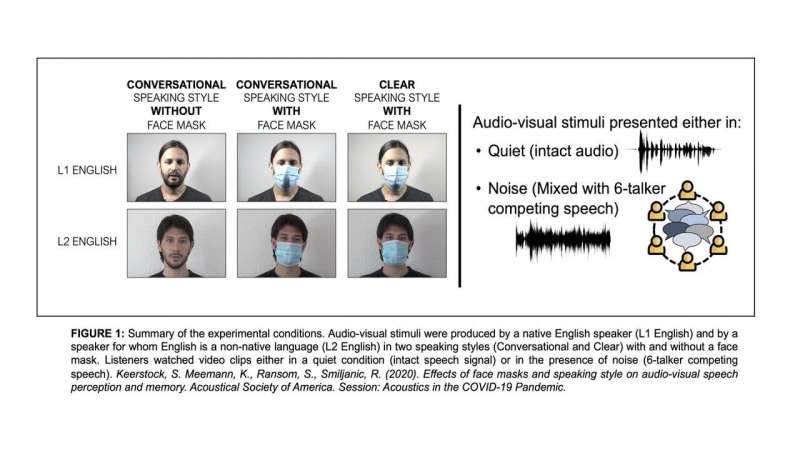Face masks provide additional communication barrier for nonnative speech

Though face masks are important and necessary for controlling the spread of the new coronavirus, they result in muffled speech and a loss of visual cues during communication.
Sandie Keerstock, at the University of Missouri, Rajka Smiljanic, at the University of Texas at Austin, and their colleagues examine how this loss of visual information impacts speech intelligibility and memory for native and nonnative speech. They will discuss these communication challenges and how to address them at the 179th Meeting of the Acoustical Society of America, which will be held virtually Dec. 7-10.
Their poster, "Effects of face masks and speaking style on audio-visual speech perception and memory," will be presented at 3:35 p.m. Eastern (U.S.) on Thursday, Dec. 10, as part of an interdisciplinary session on acoustics in the COVID-19 pandemic.
"Visual and facial cues are very important for successful communication, especially in more challenging listening situations, such as in a noisy restaurant or classroom where multiple people talk at the same time," Keerstock said. "They provide supplementary information about speech sounds that may be missing in the auditory signal due to noise."
This information can be particularly important when communicating with a nonnative English speaker, which is an especially common interaction in educational and medical settings.
Fortunately, there are simple ways to overcome these challenges to improve word recognition, intelligibility, and memory. For example, listener-oriented speech—instructing people to speak loudly and clearly—can have a large impact.
"These speaking style modifications can improve speech understanding as much or even more than the casual speech produced without a mask," Keerstock said. "In that sense, speaking clearly offsets the negative effect of lack of visual cues when communicating with protective masks."
Smiljanic recommends using supplemental means of communication when speaking with a face mask in a noisy environment, such as providing written information for crucial medical instructions or using transparent masks or sign language when appropriate, though the efficacy of all of these strategies remains to be tested.
In their next round of experiments, the authors are interested in seeing how different listeners are affected by these communication challenges—individuals with hearing loss or who are not native speakers of English and for whom communication difficulty increased during the pandemic.





















